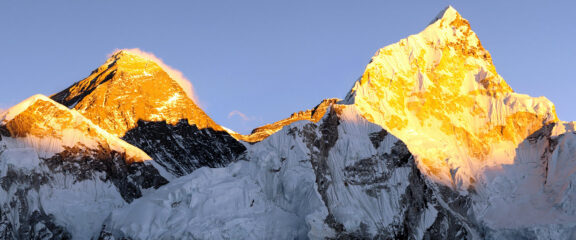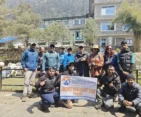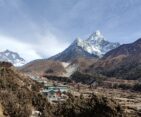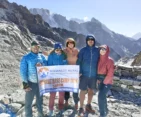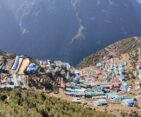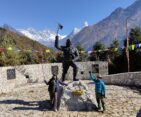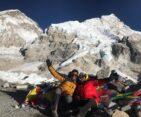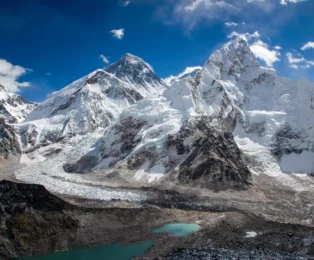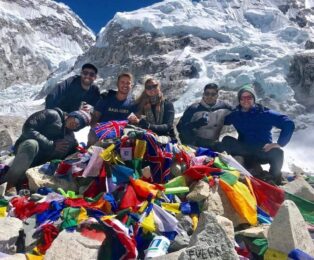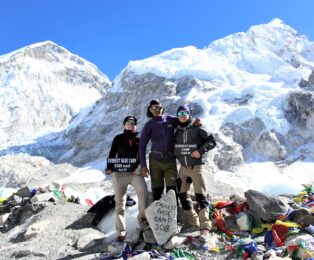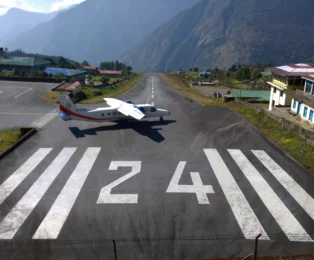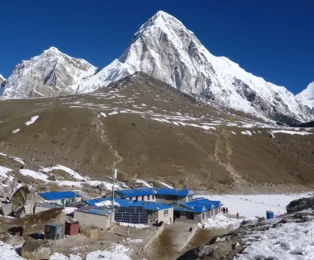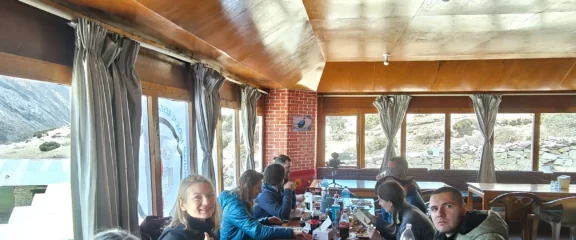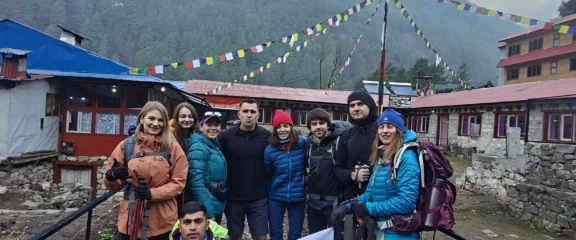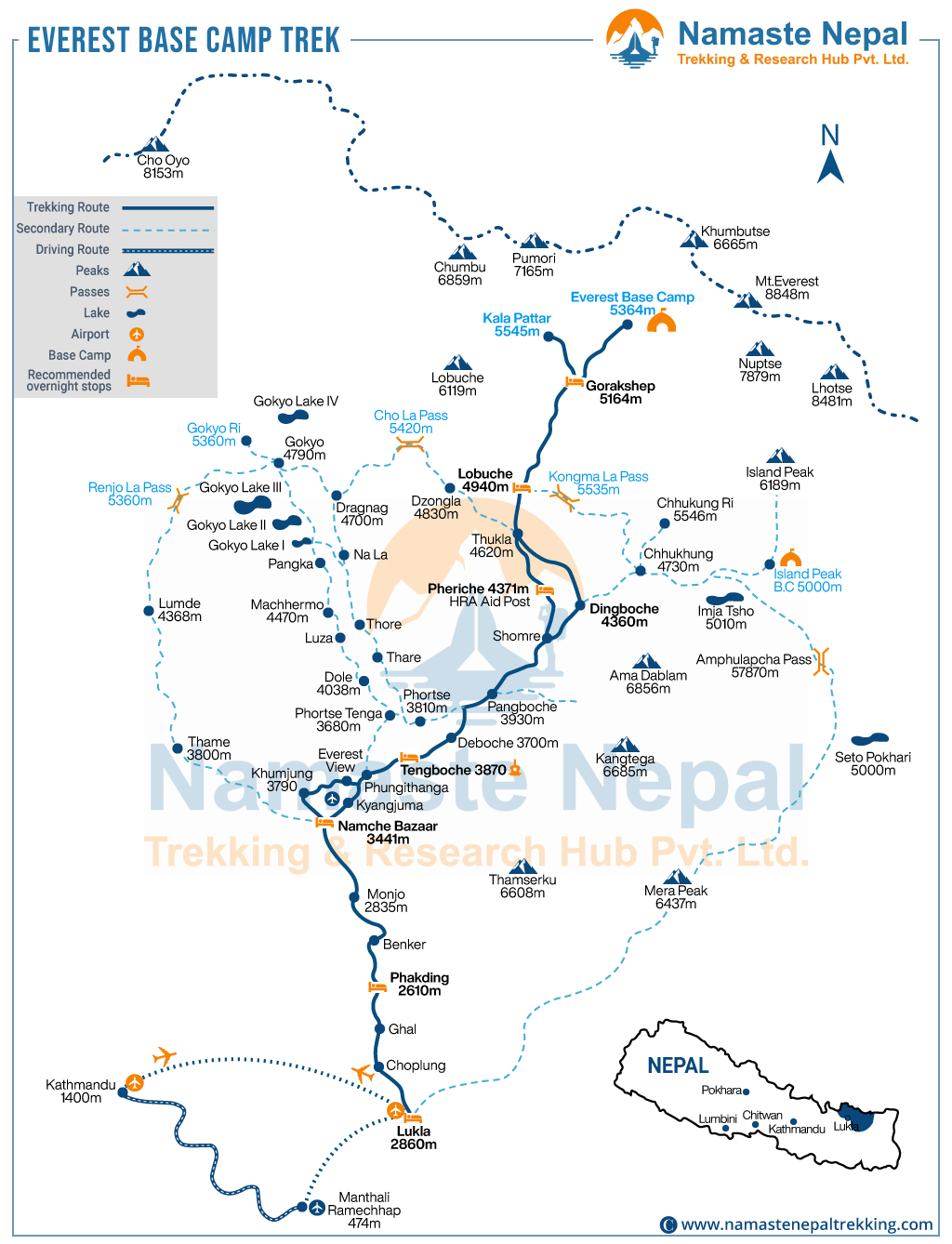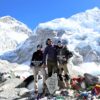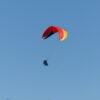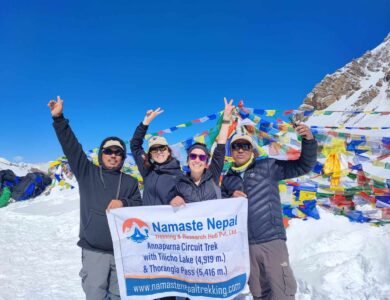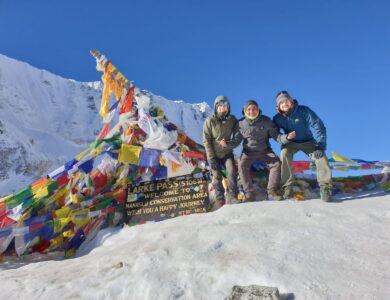Everest Base Camp Trek - 14 Days
14 Days
Moderate
Kalapattar (5,545m / 18,192 ft)
1-15 People
Kathmandu
Spring , Autumn and Early Winter
- 13 Breakfast
- 10 Lunch
- 12 Dinner
- 3 star Hotel
- Guest House with Attached Bathroom
- Guest House
- Private car
- Flights
- 1 - 1 personUS$ 1775
- 2 - 2 personUS$ 1575
- 3 - 5 personUS$ 1420
- 6 - 10 personUS$ 1350
- 11 over 9999 US$ 1270
- Your safety, our no 1 priority
- Best price guarantee
- Experienced & dedicated team
- Easy booking, no hidden charge
- You can customize this trip
US$ 1775
Highlights Of Mount Everest Base Camp Trek 14 Days
- Making the approach to the Everest Base Camp, following in the footsteps of famous mountaineers
- Visiting the remote mountain villages. Meeting the people from a diversity of ethnic groups like Sherpa, Thakali, Rai, etc, and experiencing the Tibetan Buddhist Culture
- Witnessing the raw beauty of the ice floes. Hearing the crash of the snow avalanches and the Roar of running rivers. With a new and more spectacular view day after day!
- Waking up on a crystal-clear Himalayan day and seeing 8,000-meter peaks towering over you
- Explore the Oldest and the biggest monastery of Khumbu reason, The Tengboche Monastery
- Explore the unique lifestyle, culture, tradition, and heart-warming hospitality of the Sherpa’s
- Witness panoramic views of the giant Everest massive, including Mt Everest, Mt Lotsce, Mt Nuptse, Mt Thamserku, Mt Aama Dablam. Mt Cho you, Mt Pumori, Mt kongde, Ect
- Acend to the Everest base camp with support from our experienced team of guides, crew, and support staff (porters).
Trip Overview
Everest Base Camp Trek – 14 Days is an epic journey to Everest Base Camp and Kalapatthar through stunning local Sherpa villages and Sagarmatha National Park. Primarily, the trek is to see Mt. Everest and step at Everest Base Camp, the world highest mountain base camp.
Every person dreams of stepping at Everest Base Camp and witness Mt. Everest, the top of the world and capture entire surrounding all round. But, since the trek is moderately difficult, everyone who wishes to see Everest stepping at Everest Base Camp cannot fulfill their dreams. It requires a good level of trekking stamina and preparations with the right and reliable trekking gears.
The trek begins from Lukla after a thrilling flight to Lukla Airport or a drive from Kathmandu to Manthali and a short domestic flight from Manthali to Lukla in peak trekking seasons ( Autumn and Spring) and one can directly start the trek from Lukla after a 40 minutes flight from Kathmandu.
The trail passes through various local settlements of Sherpa people and the serene shades of Sagarmatha National Park, a UNESCO World Heritage Site and the national park located at the highest elevation of the world. The national park and the local settlements will astonish you with both natural and culture astonishments including diverse species of flora and fauna, waterfalls, winding rivers fed by glaciers and freshwater lakes, the local culture of Sherpa people, and their unique lifestyle and civilization.
Along with this, you will enjoy having local cuisines of Sherpa people on the trail while passing through Lukla, Phakding, Namche Bazaar, Tengboche, Diengboche and Lobuche.
Finally, you will walk to Everest Base Camp and ascend up to Kalapatthar and witness Mt. Everest, Cho Yu, Loa Tse, Nupse, Makalu, and Pumori along with the massive and grand Khumbu Glacier. In fact, you will be marveled to see and capture such fabulous Mt. Everest and all other surrounding mountain panoramas from Kalapatthar.
You walk down to Lukla to end the trek along the same trail or optionally you can fly back by helicopter from Kalapatthar or Lobuche.
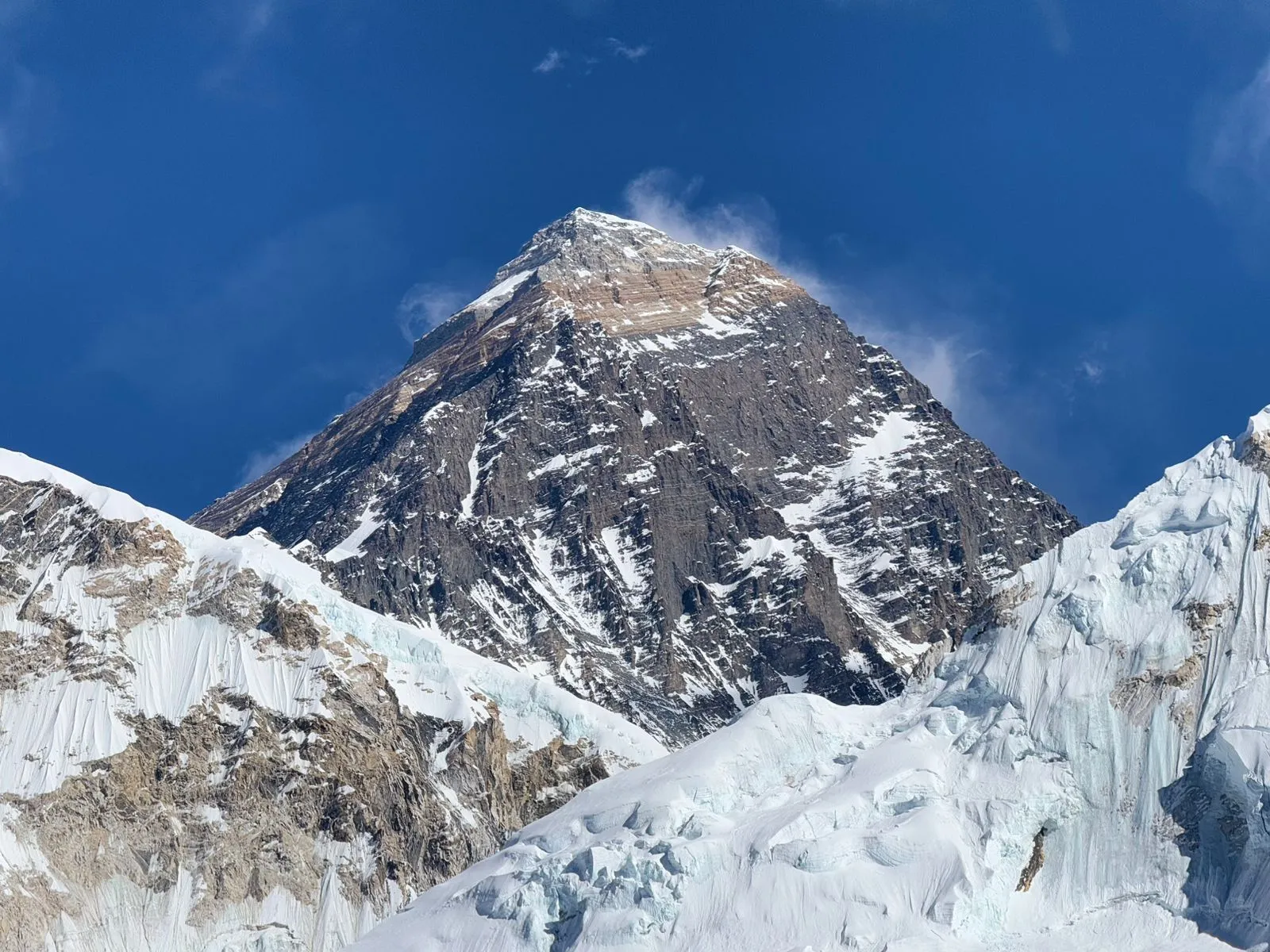
What to Expect at 14 Days Everest Base Camp Trek?
The Everest Base Camp Trekking trail is not technical with any kind of steep climb and descent. The trail is flat enough and safer to trek. There is no threat of avalanches and other landslides during the trek. The trek will be moderate till you ascend up to Tengboche and turns to be more challenging and difficult as you ascend from Dingboche and Lobuche.
You will use ordinary and common accommodation for overnight stay during your Everest Base Camp Trek. The toilet will be outside the bedroom and it will common and sharing to other people. You can have hot shower but needs to pay some extra like Rs. 300-500.
You will enjoy local Sherpa authentic cuisines and encounter with their unique culture and lifestyle. You will get astonished to see and experience their very rich cultural highlights during your Everest Base Camp Trek.
Most importantly, you will witness Mt. Everest, the top of the world and all other surrounding mountain peaks. You will have a chance to walk and step at Everest Base Camp and Kalapatthar which will create an adventure history in your life and it will be lifelong memory for you.
Mount Everest Base Camp Trek 14 Days- Is this the Right Trip for you?
Mount Everest Base Camp Trek 14 Days is graded as a moderately difficult trekking trip in Nepal. The trek begins with an easy walk from Lukla to Phakding and then it turns to be moderate while ascending up to Namche and Tengboche via Everest View Hotel.
Next, the trek tends to be challenging while ascending to Lobuche via Dingboche and turns to be more difficult while walking up to Gorekhshep, Everest Base Camp and Kalapatthar. So, the Everest Base Camp Trek requires prior trekking experiences with a good level of stamina of walking at least 5 to 7 hours a day.
If you have got prior trekking/hiking experiences ascending about 4000m with a good level of preparation including the right gears, you can successfully do this trip. If you are a beginner, Everest Base Camp Trek is not recommended. Begin and collect some trekking experiences with short and moderate treks from other trekking trails wherever you are, and then only you can get triumph over Everest Base Camp Trek.
How to prepare yourself for Everest Base Camp Trek 14 Days?
- A good level of preparation is a must to conquer over Everest Base Camp Trek as the trek is
- graded as moderately difficult. Prepare your Everest Base Camp Trek in the following ways:
- Collect and pack all required trekking gears
- Do regular physical exercises like jogging, aerobics, and walking ups and downs with a little backpack
- Join and continue outdoor sports like football, volleyball, tennis, basketball etc if possible
- Join the gym and practice cardio and other activities if possible
- Identify and fix health issues if you have got any by consulting your general physician
- Prepare a very comprehensive first Aid Kit for the trek
- Try experiencing a short or moderate trek prior to Everest Base Camp Trek if the time permits
Everest Base Camp Trek 14 days: How it Looks Like
Everest Base Camp Trek 14 days is the best and standard itinerary for Everest Base Camp Trek. The Everest Base Camp Trek 14 days will be divided into different sections of activities like walking days, arrival departure days and acclimatization days.
Actually, trekkers will spend 9 days for walking up to Everest Base Camp and walk down to Lukla. This walk to go Everest Base Camp will be for 6 days and walking down to Lukla will take 3 days.
Two days will be for acclimatization as Everest Base Camp Trek requires at least two days of acclimatization before ascending up to Everest Base Camp. The two days of acclimatization will be like this: one day at Namche Bazaar as you ascend above 3000m and the other day at Dingboche as you ascend above 4000 before heading to Everest Base Camp.
One day will be for returning back to Kathmandu from Lukla via Manthali or directly.
Two days will be for arrival and departure.
If you have one more spare day, you can adjust for the cancellation or postponement of Lukla flight in case the weather condition of Lukla gets worse.
Everest Base Camp Trek 14 Days Price
Everest Base Camp Trek Price ranges between USD 1250-2500 depending on the services and itinerary you choose. Basically, there are two types of Everest Base Camp Trek packages like basic and luxury. If you go with the basic Everest Base Camp Trek 14 Days package with ordinary accommodation on the trail, Price will be USD 1400 to 1850 depending upon the group size and if you choose to do Luxury Everest Base Camp Trek 14 Days, you need to pay USD 2400.
In the ordinary Everest Base Camp Trek 14 Days Package, you will have all required permits, a guide and porter, transportation and a normal bed and breakfast along with Lunch and Dinner. The only difference between the Ordinary Everest Base Camp Trek 14 Days Package and the Luxury Everest Base Camp Trek 14 Days package is accommodation. You will enjoy luxury suite accommodation until Dingboche in your Luxury Everest Base Camp Trek Package.
Another way of doing Everest Base Camp Trek is going with a full-board meal with all required services and trekking permits. If you go with the full-board meal, the Everest Base Camp Trek 14 Days Price will slightly rise like around USD 1700. With this package, we have offered the best price for the Everest base camp trek. Please review the inclusions and excludes carefully before booking.
Everest Base Camp Trek 12 days( For those who want to start from Lukla)
Everest Base Camp Trek 12 Days Itinerary is from Lukla to Lukla excluding your arrival and departure. It means the trekkers who are doing their Everest Base Camp Trek will spend at least 12 days walking with acclimatization. You will have two days for acclimatization: one at Namche and the other at Dingboche. So, the ten days will be for walking to and from Everest Base Camp. If you count your arrival and departure, the total days for Everest Base Camp Trek days will be 14 days.
Those who are doing Everest Base Camp have to stay 12 days in the Everest region for trekking and exploration before arriving back to Kathmandu and before departing from Kathmandu or Nepal. So, they need to prepare accordingly for their Everest Base Camp Trek.
Everest Base Camp Trek 14 Days( Booking For 2025)
Everest Base Camp Trek 14 Days for 2025 needs to be booked at least 1 month prior so that you can do a good level of preparation. You must start preparing at least 1 month prior to this trip by doing regular exercises like jogging, hiking, aerobics, outdoor games, and sports, climbing stairs, etc to boost up your stamina by walking in the mountains at least for 6 hours with a backpack.
Reserving Everest Base Camp Trek 14 Days for 2025 prior to 1 month is a good idea so that you can save your trip and can collect all required trekking equipment. Getting and packing the right trekking equipment is like accomplishing 25% of your trekking trip. Trekking with the right equipment will help you get triumph over a particular trekking trip and the same thing goes for Everest Base Camp Trek.
More number of people will join Everest Base Camp Trek 14 Days as the trip is getting more popular among adventure enthusiasts around the world. So, you are suggested to reserve your Everest Base Camp Trek 2025 in case all the packages are sold out.
Note: If you come up with a sudden planning we also accept the Last Hour Booking for the Everest Base Camp Trek.
Everest Base Camp Trek 14 Days Booking For 2026 and 2027
Everest Base Camp Trek for 2026 and 2027 also can be booked now. Even though it seems a little earlier. Some people who prepare for their holidays a year earlier as they can get some discount too according to the policy of the trekking company. If you reserve your Everest Base Camp Trek 14 Days 2025 or for 2026, you don’t need to worry about the change in cost as the cost of the services are going up every year. Do comprehensive research on Everest Base Camp Trek 2025 and 2026. Book it with a reliable and authorized trekking company like us.
Everest Base Camp Trek Distance
The Everest Base Camp Trek Distance from Lukla to Lukla is 65 km. You will spend a minimum of 10 days (7 days going up and 3 days descending to Lukla). So, the average working hours is 6 and the average distance you cover daily is about 7 km. So, the trekkers who are doing their Everest Base Camp Trek are required to cover at least 7 kilometers daily. Prepare to walk 7 kilometers daily by boosting up your stamina. You can walk 7 kilometers a day comfortably until Namche Bazaar, but it will be very difficult after you ascend above Tengboche and Dingboche.
Everest Base Camp Trek 14 Days Booking with Namaste Nepal
Everest Base Camp Trek Booking is Open now and you can reserve your trip for the future. You book the trip for 2025, 2026, and even for 2027. Booking the trip in advance offers enough time to collect and prepare all the resources and things for Everest Base Camp Trek. For the booking, you can click Book now and follow simple steps. or email us at [email protected] or whataap us at +977-9843294000
Everest Base Camp Trek 14 Days Online appointments for free consultation
Everest Base Camp Trek 14 Days Online Appointments for Free Consultation are available and possible with us. Our expert team led by Mr. Rajan is ready to provide you with very authentic and comprehensive information about Everest Base Camp Trek before you begin the trip. You can book the online appointment with us via Google Meet, Zoom, or WhatsApp Call. Fix your time schedule and ask us to provide the information or you can ask us the information about Everest Base Camp Trek
We have local expert guides and travel experts who have more than 10 years of work experience in Everest region especially leading the trekkers to EBC and back successfully. You can rely on them and inquire about any information you like for the right and organized preparation of the Everest Base Camp completely free of cost.
Everest Base Camp Trek 14 Days: Guided Trek
Everest Base Camp Trek 14 Days with Guide from reputed trekking agency is far better than independent trek. If you accompany with your guide, you will comfortably get victory over Everest Base Camp Trek your trekking guide helps you in every step of your walk. He/she manages all required accommodation, transportation, meals, and other resources for the trek, trekking permits, drinking water and shower, communication and gives you right walking tips throughout the trek.
The guide will help you tremendously when you have some sudden issue like altitude sickness or any other accidents on the Everest Base Camp Trek 14 Days. But if you go independently without guide, you have to rely on your own for every single activity you carry on the trip and you may not know all the things that you have to adopt during your Everest Base Camp Trek; there may be some lacking and that may bring bigger and more terrible disasters.
Therefore, one who is doing Everest Base Camp Trek 14 Days is highly recommended to take a professional, local, and experienced guide all around the trip. Everest Base Camp Guided Trek is highly recommended over an independent Everest Base Camp Trek.
Recommended Equipment Packing for EBC Trek
The following basic equipment checklist for Everest Base Camp Trek is designed to assist you in preparing for your trek. Packaging efficiently and keeping your gear’s weight as light as possible to ensure a comfortable trekking experience is important.
At the beginning of your trek, your packed bag should weigh no more than 33 pounds (15 kg). This weight limit helps to ensure that our Porter can carry your bag comfortably. Please review the checklist carefully and pack accordingly to maximize your enjoyment and minimize any unnecessary strain.
- Sun hat or scarf
- Warm fleece hat
- Sunglasses with UV protection
- Warm beanie
- Buff or neck gaiter
- Moisture-wicking T-shirts
- Fleece jacket or pullover
- Fleece Wind-Stopper jacket (optional)
- Waterproof (preferably breathable fabric) shell jacket
- Down jacket or synthetic insulated jacket
- Lightweight gloves and or
- Heavyweight gloves
- Under Garments
- Hiking shorts
- Lightweight cotton long pants
- Fleece or wool pants (seasonal)
- Waterproof pants
- Lightweight trekking pants
- Thermal pants (for Higher and colder regions)
- Thin, lightweight inner socks
- Thick, warm wool hiking socks
- Hiking boots with spare laces
- Camp shoes (sneakers and/or sandals)
- Sleeping bag
- Sleeping bag liner (for added warmth)
- Map and compass/GPS
- Headlamp with extra batteries
- Daypack (20-30 liters)
- Duffle bags
- Basic First Aid Kit
- Regular medicine
- Trekking Poles
- Water bottles or hydration system (at least 2 liters capacity)
- Water purification tablets or filter
- Solar charger or power bank
- Multi-tool or knife
- Medium-sized quick-drying towel
- Toothbrush/paste
- Multipurpose soap
- Deodorants
- Nail clippers
- Face and body moisturizer
- Sunscreen (SPF 30 or higher)
- Lip balm with SPF
- Personal Hygiene
- Wet wipes (baby wipes)
- Tissue / toilet roll
- Anti-bacterial hand wash
- Reading book
- Trail Map/Guidebook
- Lightweight reading material or Journal with Pen
- iPod/Smartphones
- Pencils and small notebooks
- Camera and spare batteries
- Snacks and energy bars
- Gaiters (for snow or muddy trails)
- Lightweight binoculars
- Portable trekking pillow
- Travelling games (Uno, playing cards, dice, etc)
- Trekking permits and
- Copies of important documents (passport, insurance)
- Cash for tea houses, tips, and small purchases
- Travel insurance details
- Emergency contact information
- Layering: Dress in layers to manage temperature changes easily.
- Breaking in Gear: Make sure all gear, especially boots, is not broken and comfortable before the trek.
- Weight Management: Keep your backpack weight as light as possible without sacrificing essential items.
- Training: Physical preparation is key; train with hikes and exercise to build endurance.
Outline Itinerary of Everest Base Camp Trek 14 Days
Arrival in Kathmandu & Pre Trip Meeting
Fly to Lukla from Kathmandu or Manthali and Trek to Phakding
Trek to Namche Bazaar
Acclimatization and Rest day at Namche Bazaar
Trek to Tengboche Village
Trek To Dengboche
Acclimatization and rest day at Dingboche
Trek To Lobuche
Trek to Everest Base Camp (5,364m / 17,599 ft) then trek back to Gorakshep
Trek / Climb to Kalapattar (5,545m / 18,192 ft) then trek down to Pheriche
Trek to Namche Bazaar
Trek Back To Lukla
Fly to Kathmandu
Departure Day
Why I advocate for Everest Base Camp Trek 14 Days: Insights from the founder
Me, Rajan began my career in tourism in 2009 as a porter. I was promoted to trekking leader after having training and a license in a few years. Then, I served as a trekking leader for 12 years leading groups in various regions of Nepal like Annapurna, Langtang, Mustang, Manaslu, and Everest. Among them, I always preferred taking the groups in the Everest region, specifically, Everest Base Camp.
Actually, there are a few reasons why I advocate this trip: Trek to Everest Base Camp. This trip is the grandest of all trekking trips in Nepal. Everyone’s common and shared dream is to witness Mt. Everest from the closest viewpoint that is Everest Base Camp and Kalapatthar and one can set a lifetime history before the die by stepping at Everest Base Camp.
I have seen the people who have successfully completed their Everest Base Camp Trek celebrated as the biggest achievement in their lives. Therefore, I firmly and solely advocate for Everest Base Camp Trek: A Must Do Trek in one’s lifetime.
What I like the most about Everest Base Camp Trek 14 Days
What I like most about Everest Base Camp Trek 14 Days is: Stepping at Everest Base Camp, the highest mountain base camp of the world as you have set a new adventure history in your life. Secondly, ascending up to the top of Kalapatthar and capturing majestic Mt. Everest, Pumori, Loa Tse, Nupse, Makalu and Cho Yu will be a marvelous moment for the trekkers. Thirdly, walking through Sagarmatha National Park, a UNESCO World Heritage Site and the highest national park of the world, experiencing its diverse species of flora and faunas will be another memorable moment for the trekkers. Fourthly, the local civilization of the Sherpa people, the lifestyle of the people, and authentic local cuisines will let you taste something very distinct during the trip to Everest Base Camp and back. Lastly, hitting the trail used by legendary Everest climbers: Edmund Hillary and Tenjing Norgay Sherpa will be another massive achievement and experience for the trekking during their Everest Base Camp Trek.
Why come on an adventure with team Namaste Nepal for your Everest Base Camp Trek?
- Better trekking experiences
- Safer and more exciting trekking trip
- Trekking with the highly experienced and professional team
- Flexible and convenient trekking itinerary
- Immediate help and Rescue in case of emergency
- Local guides and porters who can impart more authentic information
- Reliable and transparent services
- Better transportation and accommodation facilities
Experience the adventure of a lifetime at the lap of Mighty Everest
All Adventure enthusiasts wish to follow in their footsteps at Everest Base Camp (5364m), the highest mountain base camp in the world and set an adventure history in their lives. Don’t you wanna do so? Yes, definitely you do want it, right? If you have got that kind of physical stamina and confidence with prior trekking experience, you can win over Everest Base Camp and celebrate this incredible adventure in your life.
People want to do something new and want to set a legacy of adventure in their lifetime. One of the most important things to do in their life they choose doing in Everest Base Camp Trek successfully and create a history and they want to pass on this incredible legacy to their descendants.
You also can do the same as an adventure passionate setting up you real footsteps at Everest Base Camp and Kalapatthar from where you can witness the most mesmerizing Mt. Everest, the top of the world and other majestic mountain summits above 8000m.
Let’s prepare for the Everest Base Camp Trek and conquer it for a lifetime adventure history.
Alert: The Lukla Flights will Be Operated from Manthali Airport Ramechhap!
During the peak trekking season months Autumm (Mid September, October, November) and Spring (April, May) the Lukla flights are operated from Manthali Airport Ramechhap. At other times of the year, the regular flights are operated from Kathmandu to Lukla to Kathmandu Directly!
If you are traveling in a Peak Seasons, to catch a Flight from Manthali Airport Ramechhap, we must Leave Kathmandu at Midnight on the Scheduled Departure Date unless you do not have a extra day! It will take about 4-5 hour drive from Kathmandu to Manthali and just 15 to 20 minutes flight to Lukla.
Stay tuned for the update about the timing of the Lukla Flight!
Photo & Video Gallery
Detailed Itinerary of Everest Base Camp Trek
Day 1: Arrival in Kathmandu & Pre Trip Meeting
Upon your arrival in Kathmandu, our representative from Namaste Nepal Trekking & Research Hub will pick you up from the airport. He will be displaying our company sideboard with your name on it outside the airport terminal. Transfer to the selected hotel.
In the afternoon the pre-trip meeting will be holding at our office. During this meeting we will introduce your trek and or tour leader/guide, so please make sure that you ask all the questions and concerns. For the meeting please make sure you bring a passport,2 copies of passport-size photos, and your travel insurance policy copy (if you haven’t sent it by email before). And sign the legally binding trip form as well as the non-liability disclaimer.
Then head out and visit one of Kathmandu’s cultural highlights. In the evening, the tourist hub of Thamel is a good place to grab your first meal, with a variety of restaurants to chose from offering both Western and local Nepali dishes.
Activity
ArrivalTrip Duration
30 minDistance
5.6 kmMax Altitude
1,400m / 4,593ftAccommodation
3-Star HotelDay 2: Fly to Lukla from Kathmandu or Manthali and Trek to Phakding
Your Journey to the Mount Everest Base Camp Starts here!
It is an exciting and memorable experience as it marks the beginning of your journey to the base of the world’s highest mountain. The day starts early, as you will board a flight from Kathmandu to Lukla, which is the gateway to the Everest region. The flight to Lukla is one of the most adventurous and scenic flights in the world, as the plane takes off from Kathmandu’s domestic airport and flies over the beautiful Himalayan range.
As you approach Lukla, the view of the surrounding mountains becomes more and more stunning. The airport is small and is located at an elevation of 2,860 meters (9,383 feet). Once you land, you will meet the rest of your trekking team of Assistance Guides and Porter / Support Staff. After a brief introduction and a hot cup of tea, you will begin your trek to Phakding, which is a small village located at an elevation of 2,610 meters (8,562 ft).
The trail from Lukla to Phakding is relatively easy and takes around 3-4 hours to complete. Along the way, you will pass through small Sherpa villages and cross several suspension bridges over the Dudh Kosi River. The trail is well-defined and offers beautiful views of the surrounding mountains, Spectacular mountain peaks unfold above us and seem to hover above the tree line as they rise above the deep river valley. Shortly after leaving camp, we cross the Kusum Khola, a tributary stream to the Dudh Kosi, and the peak of Kusum Kanguru (6369 m) can be seen to the East, at the head of the valley. Further along the trail, across the valley to the North-West, Nupla (5885 m) and Kongde Ri (6093 m) rise above the forested ridges. At the turn of the trail, Thamserku (6808 m) rises majestically, The local people are very friendly and welcoming, and you will have the opportunity to learn about their culture and way of life.
As you reach Phakding, you will check into your teahouse, which is a basic accommodation facility that provides simple rooms and basic amenities. After freshening up, you will have dinner with your team and then rest for the night. The first day of the trek is relatively easy and serves as a good acclimatization day before you begin the more challenging days ahead.
Note: Flight from Manthali Airport, Ramechhap.
During the peak trekking seasons ( Autumn and Spring), the Lukla flights are operated from Manthali airport. We will let you know how you will fly to Lukla once the trip is confirmed and your travel date is nearby!
If you have to Fly from Manthali Airport Ramechhap, Your guide will pick you up from the hotel you stay and transfer you to Manthali Airport, Ramechhap. It takes 4-5 hours to get Ramechhap from Kathmandu. You are required to leave Kathmandu at around 2 am in the morning for Manthali Airport, Ramechhap.
After you get to Manthali Airport Ramechhap, you will take a flight of 20 minutes to Lukla Airport with marvelous mountain views in the Everest region. once you reach Lukla the other program remains the same!
Activity
Fly & TrekkingTrip Duration
3-4 HoursDistance
7.8 km TrekkingMax Altitude
2,800m / 9,186ftMeals
Breakfast , Lunch & DinnerAccommodation
Guest House with Attached BathroomDay 2: Trek to Namche Bazaar
Day to the Namche Bazaar begins with an early morning breakfast in Phakding. After packing your bags and saying goodbye to your guesthouse, the trail starts with a gradual ascent along the Dudh Koshi River. The river is a major source of water for the local communities and the sound of its rushing water will be a constant companion throughout the trek.
As you walk, you will come across several suspension bridges that you will need to cross. These bridges are built to withstand the strong currents of the river during the monsoon season and offer a thrilling experience as you walk across them. The trail also passes through small Sherpa villages, where you will have a chance to interact with the local people and learn about their way of life.
As the trail progresses after Lunch, It begins to become steeper and more strenuous. the trail passes through the forest of pine to a vantage point that provides our first view of Mt Everest. But the views become more and more breathtaking as you approach Namche Bazaar. Namche Bazaar is the largest town in the Khumbu region and a major hub for trekkers and climbers. It is situated at an altitude of 3,441 meters (11,290 feet) and offers stunning views of the surrounding mountains, including Mt. Everest, Mt.Nuptse, Mt.Lhotse, Mt.Ama Dablam, Mt.Thamserku, and many more.
The town is also home to several shops, restaurants, Bars, Banks, Hotels, and guesthouses where you can rest and acclimatize before continuing your journey. It is crucial to spend a day here to give your body time to adjust to the altitude before continuing on to higher elevations. Namche Bazaar is also a great place to explore as it has a vibrant market and a number of Buddhist monasteries that are worth visiting.
After spending the night in Namche Bazaar, you will be well-rested and ready to tackle the next leg of the trek. The trail ahead will be challenging, but the rewards in terms of scenery and cultural experiences will be well worth it.
Activity
TrekkingTrip Duration
5-6 HoursDistance
11.3 KmMax Altitude
3,441m / 11,289ftMeals
Breakfast , lunch & DinnerAccommodation
Guest House with Attached BathroomDay 4: Acclimatization and Rest day at Namche Bazaar
The 4th of the Everest base camp trek is typically an acclimatization and rest day at Namche Bazaar. Namche Bazaar is situated at an altitude of 3,441 meters (11,290 ft) and it is essential to spend a day here to give your body time to adjust to the altitude before continuing on to higher elevations. Altitude sickness can occur when ascending too quickly to high altitudes, and it is important to take the necessary precautions to prevent it.
During the acclimatization day, you can take a short hike to a nearby viewpoint to get a better view of the surrounding mountains and to help your body adjust to the altitude. A popular option is a hike to the Syangboche Airport, which offers panoramic views of the Himalayas, including Mt. Everest, Mt.Nuptse, Mt.Lhotse, Mt.Ama Dablam, Mt.Thamserku, Mt. Kongde, and many more.
Another option is a visit to the nearby Khumjung village, home to the Hillary School and the Hillary Memorial Museum, dedicated to Sir Edmund Hillary and his work in the region. The school was built by Sir Edmund Hillary and provides education for local Sherpa children.
In addition to sightseeing and hiking, you can also take the opportunity to rest and recover from the previous days of trekking. You can visit local shops, purchase souvenirs or try some local food, and enjoy the local culture. Namche Bazaar has several restaurants, cafes, and shops selling trekking gear, and you may find some things you need for the rest of your trek.
It is also important to stay hydrated and to drink plenty of water to avoid altitude sickness. You should also avoid alcohol and smoking as it can worsen the symptoms of altitude sickness.
The Benefit of Acclimatization.
Acclimatization is the process by which the body adapts to changes in altitude and helps to prevent altitude sickness. When ascending to high altitudes, the body needs to adjust to the lower levels of oxygen in the air. Acclimatization allows the body to do this by increasing the efficiency of the respiratory and cardiovascular systems.
The following are some of the benefits of acclimatization:
- Increased oxygen-carrying capacity: The body produces more red blood cells to carry oxygen to the muscles and organs, which helps to reduce fatigue and improve overall performance.
- Improved lung function: The body adjusts the breathing rate and increases the efficiency of the lungs to extract oxygen from the air.
- Reduced risk of altitude sickness: Acclimatization reduces the risk of altitude sickness, which can range from mild symptoms such as headache and fatigue to severe symptoms such as High Altitude Pulmonary Edema (HAPE) and High Altitude Cerebral Edema (HACE).
- Increased endurance: The body becomes more efficient at using oxygen, which allows trekkers to trek for longer periods of time and cover more distance.
- Better sleep: The body adjusts to the lower levels of oxygen at high altitudes and improves the quality of sleep, which allows trekkers to wake up feeling refreshed and ready for the next day.
It is important to note that acclimatization is a gradual process and should not be rushed. It’s crucial to take the necessary precautions and to spend sufficient time at lower altitudes to allow your body to adjust before continuing to higher elevations.
Activity
Acclimatization and RestMax Altitude
3,800m / 12,467ftMeals
Breakfast , Lunch & DinnerAccommodation
Guest House with Attached BathroomDay 5: Trek to Tengboche Village
Today’s trek involves a trek from Namche Bazaar to Tengboche. After spending a day acclimatizing in Namche Bazaar, You will begin your journey toward Tengboche Village. The trail starts with a gradual ascent, passing through beautiful rhododendron and pine forests, and offers excellent views of the surrounding mountains.
As we journey from Namche Bazaar to Tengboche village, we pass through some breathtaking landscapes and charming villages. Our first stop is at Kyangjuma village, where we take a much-needed tea break. The village is known for its charming traditional homes and its stunning views of the surrounding mountains. The views of Mt. Everest and Mt. Ama Dablam are one of the best of the entire trek. The locals are warm and friendly, and the tea houses serve some of the best tea in the region with fresh homemade bread and cakes.
Continuing our journey, we pass through verdant forests, rolling hills, and lush pastures. The trail is well-trodden and the scenery is breathtaking. The smell of fresh pine and the sound of rushing streams accompany us on our journey.
For lunch, we make a stop at Phunki Tenga, a small picturesque village perched on the bottom of a hill. Here, we savor delicious traditional food and take in the views of the Dudh Koshi River, the Beautiful Suspancen Bridge, and the surrounding valleys. The village is known for its warm hospitality, and visitors are always greeted with a smile.
As we continue our journey to Tengboche, we pass by lots of stairs, Chautara(where porters take a rest climbing up and downs with loads), and colorful prayer flags strung up on the hills. We encounter yaks and horses grazing on the slopes. The journey is an unforgettable experience, filled with breathtaking beauty and a sense of peace and Hard work.
Tengboche is a small village located at an altitude of 3,870 meters (12,697 ft) and is home to the Tengboche Monastery, the largest monastery in the Khumbu region. The Tengboche Monastery is an important Buddhist monastery and a major pilgrimage site for the Sherpa people. The monastery is also a great place to visit for trekkers as it offers a glimpse into the religious and cultural heritage of the region.
After visiting the monastery, you can rest and acclimatize in Tengboche before continuing your journey to the next destination. Tengboche offers several guesthouses and restaurants where you can enjoy a hot meal and rest before continuing your trek.
Activity
TrekkingTrip Duration
5-6 HoursDistance
12 kmMax Altitude
3,870m / 12,697ftMeals
Breakfast , Lunch & DinnerAccommodation
Guest House with Attached BathroomDay 6: Trek To Dengboche
Trekking from Tengboche village to Dingboche village is a journey through breathtaking landscapes and scenic views. As you embark on this journey, you’ll cross the quaint village of Dibuche, a 30-minute trek away from Tengboche. This small settlement offers a glimpse into the traditional lifestyle of the Sherpa community, surrounded by stunning peaks, and is known for its traditional wooden homes and fertile terraced fields.
As you continue your journey, you’ll reach the village of Pangboche for a much-needed tea break. Pangboche is known for its traditional tea houses that offer a warm and comfortable respite from the chilly mountain air. You can sit down, enjoy a cup of hot tea, and take in the stunning views of the surrounding peaks.
The trail then leads you through the Imja Valley, a lush green valley surrounded by towering peaks. This is a scenic and tranquil place that offers a perfect respite from the steep ascent to Dingboche. The trail follows the Imja Khola, a glistening stream that winds its way through the valley, providing a refreshing sight and sound along the way.
As you approach lunchtime, you’ll reach the small village of Shomare, where you can take a break, enjoy a hearty meal, and replenish your energy levels. The local eateries serve traditional Nepalese dishes and some of the best momos in the region. After a well-deserved lunch break, you’ll continue on your trek to Dingboche, the next stop on your journey.
Dingboche is a small village located at an altitude of 4,360 meters (14,305 ft) and offers spectacular views of the surrounding mountains, including Mt. Ama Dablam, Lhotse, and Makalu. It is an ideal place to rest and acclimatize before continuing on to higher elevations. Dingboche is also home to several lodges and teahouses where trekkers can rest and enjoy a hot meal.
In Dingboche, you can also take a short hike to nearby hilltops to get better views of the surrounding mountains and to help your body adjust to the altitude. A popular option is a hike to Nagarjun Hill, which offers panoramic views of the Himalayas.
Activity
TrekkingTrip Duration
5-6 HoursDistance
8kmMax Altitude
4,360m / 14,304ftMeals
Breakfast , lunch & DinnerAccommodation
Guest House with Attached BathroomDay 7: Acclimatization and rest day at Dingboche
Today is typically an acclimatization and rest day at Dingboche. Dingboche is situated at an altitude of 4,360 meters (14,305 ft) and it is essential to spend a day here to give your body time to adjust to the altitude before continuing on to higher elevations. Altitude sickness can occur when ascending too quickly to high altitudes, and it is important to take the necessary precautions to prevent it.
During the acclimatization day, you can take a short hike to a nearby viewpoint to get a better view of the surrounding mountains and to help your body adjust to the altitude. A popular option is a hike to Nagarjun Hill, which offers panoramic views of the Himalayas, including Mt. Ama Dablam, Lhotse, and Makalu.
After the morning Acclimatization hike, you can take a good rest to recover from the previous days of trekking and prepare for the next leg of the journey. You can visit local shops, Play with your team, purchase souvenirs or try some local food, enjoy the local culture, and catch up on your journal or read a book.
It is also important to stay hydrated and to drink plenty of water to avoid altitude sickness. You should also avoid alcohol and smoking as it can worsen the symptoms of altitude sickness.
Overall, the rest day at Dingboche allows you to take a break and recharge before continuing on to the next leg of the trek, while also allowing your body to adjust to the altitude. This will also give you an opportunity to admire the beauty of the Himalayas and get a sense of the scale of the mountains as you trek through the region.
The Benefit of Acclimatization.
Acclimatization is the process by which the body adapts to changes in altitude and helps to prevent altitude sickness. When ascending to high altitudes, the body needs to adjust to the lower levels of oxygen in the air. Acclimatization allows the body to do this by increasing the efficiency of the respiratory and cardiovascular systems.
The following are some of the benefits of acclimatization:
- Increased oxygen-carrying capacity: The body produces more red blood cells to carry oxygen to the muscles and organs, which helps to reduce fatigue and improve overall performance.
- Improved lung function: The body adjusts the breathing rate and increases the efficiency of the lungs to extract oxygen from the air.
- Reduced risk of altitude sickness: Acclimatization reduces the risk of altitude sickness, which can range from mild symptoms such as headache and fatigue to severe symptoms such as High Altitude Pulmonary Edema (HAPE) and High Altitude Cerebral Edema (HACE).
- Increased endurance: The body becomes more efficient at using oxygen, which allows trekkers to trek for longer periods of time and cover more distance.
- Better sleep: The body adjusts to the lower levels of oxygen at high altitudes and improves the quality of sleep, which allows trekkers to wake up feeling refreshed and ready for the next day.
It is important to note that acclimatization is a gradual process and should not be rushed. It’s crucial to take the necessary precautions and to spend sufficient time at lower altitudes to allow your body to adjust before continuing to higher elevations.
Activity
HikkingMax Altitude
5,100m / 16,732ftMeals
Breakfast , Lunch & DinnerAccommodation
Guest House with Attached BathroomDay 8: Trek To Lobuche
After spending a day acclimatizing in Dingboche, you will continue your journey toward Lobuche. The trek from Dingboche to Lobuche is a challenging but unforgettable journey through the heart of the Himalayas. As you leave Dingboche and head towards Lobuche, you will experience the raw beauty of the landscape and the power of the towering peaks.
One of the first things you will notice as you leave Dingboche is the lack of trees and vegetation. The air is thin and crisp, making it a bit challenging to breathe, but the lack of vegetation provides an unobstructed view of the towering peaks. With 360-degree views of the surrounding mountains, you will feel as though you are truly in the heart of the Himalayas.
Along the way, there are no villages, but there is a welcome break at Dunghla/Thokla Village for lunch. This small village is known for its warm hospitality and beautiful views of the surrounding hills. It’s a great place to rest and recharge before continuing on your journey.
After lunch, the trail becomes a steep climb up to the Everest Memorial Tombstones. This memorial is dedicated to the Sherpa and mountaineers who have lost their lives climbing Mt. Everest. The memorial is covered with Mani Walls and Prayer Flags, symbolizing the deep spiritual significance of the mountains to the local people. The views from the memorial are truly awe-inspiring, with breathtaking panoramic views of the surrounding peaks, including the imposing Pumori, Nuptse, and Lhotse.
Finally, the trail reaches the Thokla Pass, one of the most challenging and rewarding parts of the trek. The pass is steep and rocky, but the views from the top are truly breathtaking. From the pass, the trail starts trekking through the Khumbu Glacier, surrounded by the towering peaks of the Himalayas.
Lobuche is a small village located at an altitude of 4,940 meters (16,208 ft) and offers spectacular views of the surrounding mountains, including Mt. Pumori, Mt. Ama Dablam, and Mt. Nuptse. It is an ideal place to rest and acclimatize before continuing on to Gorak Shep, the last stop before Everest Base Camp. Lobuche has several teahouses and lodges where trekkers can rest and enjoy a hot meal.
After reaching Lobuche, you can take a short hike to a nearby viewpoint or visit Gorak Shep Lake and the nearby glaciers. This will allow you to get a sense of the scale of the mountains and the harsh conditions of the high-altitude environment.
Activity
TrekkingTrip Duration
4-5 HoursDistance
12kmMax Altitude
4,940m / 16,207ftMeals
Breakfast , lunch & DinnerAccommodation
Guest HouseDay 9: Trek to Everest Base Camp (5,364m / 17,599 ft) then trek back to Gorakshep
The trek from Lobuche to Gorakshep to Everest Base Camp is a culmination of the entire trekking experience in the Himalayas. This final stretch of the trek is the most exciting and the highlight of the entire journey. As you set out from Lobuche, you are immediately greeted by the stunning panoramic views of the towering peaks and glaciers, surrounded by the thin air that makes breathing a bit more challenging.
The trail takes you through the heart of the Himalayas and towards Gorakshep, the last settlement before you reach the Everest Base Camp. Gorakshep is a small settlement located at an altitude of 5,180 meters (16,994 ft) and is the final stop for trekkers before they reach the base camp. Here, you will have the opportunity to check in at the guest house and have lunch before continuing your journey to the Everest Base Camp.
The journey from Gorakshep to the Everest Base Camp is truly breathtaking. As you make your way through the trail, you will be surrounded by towering peaks and glaciers, offering a 360-degree view of the stunning landscape. The trail to the Everest Base Camp is challenging, but the reward is worth every step. Once you reach the base camp, you will be able to explore the site and see what it’s like to be at the foot of the world’s tallest mountain. You will see the climbers’ camps, the Sherpa’s villages, and the breathtaking panoramic views of the surrounding peaks.
After exploring the Everest Base Camp, you will trek back to Gorakshep, where you will have the option to rest and relax, or if you have time and energy, you can take an alternative route to see the sunset views from Kalapatther. This sunset view offers one of the most breathtaking panoramic views of the surrounding peaks and glaciers and is truly a once-in-a-lifetime experience.
Facts about the Everest Base Camp
History of the Everest Base Camp.
The first successful ascent of Mount Everest was made by Sir Edmund Hillary and Tenzing Norgay Sherpa in 1953. The base camp is located on the southern side of the mountain in Nepal and has since then become the starting point for climbers attempting to reach the summit.
Views from the Everest Base Camp.
The Everest Base Camp is a mesmerizing place that offers breathtaking views of the towering peaks of the Himalayas. At an altitude of 5,364 meters (17,599 ft), it is the starting point for those attempting to climb Mount Everest, the highest peak in the world.
One can see Mount Everest, Lhotse, Nuptse, Pumori, Makalu, Khumbuste, Cho Oyu, and many other mountains that form part of the Himalayan range. The Khumbu Glacier, which is the largest glacier in the world, is also visible from here. The Khumbu Ice Fall, a treacherous section of the glacier, can also be seen from the base camp.
Small glacier lakes, tents, and climbers can also be seen in the area. The base camp is a busy hub of activity, as mountaineers and Sherpa climbers prepare for their journey to the top of the mountain. It is an awe-inspiring place that is sure to leave a lasting impression on those who visit.
What to do in the Everest Base Camp.
At the base camp, you can explore the site, learn about the history of the first ascent, and take in stunning views. Capture memories of your journey to the base camp by taking photos and videos of the stunning views and experiences. Share your experiences with friends and family back home.
The base camp is a hub of activity during the climbing season, with hundreds of climbers, sherpas, and support staff setting up camp. you can visit them when you are there.
The base camp is not permanently inhabited, but tents and supplies are set up during the climbing season to accommodate climbers and support staff. you can visit their camp when you are there.
Activity
TrekkingTrip Duration
6-7 HoursDistance
11.2kmMax Altitude
5,364m / 17,598ftMeals
Breakfast , Lunch & DinnerAccommodation
Guest HouseDay 10: Trek / Climb to Kalapattar (5,545m / 18,192 ft) then trek down to Pheriche
After spending a cold night at Gorakshep, You prepare for an early morning departure, amid pre-dawn darkness and cold temperatures (-10 to -14 C). Plus, there is always the potential for chilly winds which are quite common. Familiar peaks such as Pumori, Khumbutse, and Changtse tower to the east even as Everest, Lothse, and Nupse begin to reveal themselves. But, it is upon reaching Kala Patthar that you get to see 360 degrees up-close and formidable views of Mt. Everest. You take pictures, Videos, and enjoy the magnificent mountain panorama, it’s a great opportunity to get a close-up view of the highest mountain Panorama in the world.
Once you have marveled at the sunrise, you will make your way back to Gorakshep for a hearty breakfast. After filling up, you will start your descent down to Pheriche, stopping for a tea break at Lobuche. Here, you can enjoy a warm cup of tea and take in the stunning views of the surrounding peaks.
Your final stop for the day will be at Thokla, where you will have lunch and refuel before continuing on to Pheriche.
Pheriche is a small village located in the Khumbu region and offers a good place to rest and acclimatize before continuing on to other destinations. It’s also a good place to explore the local culture and interact with the local people. Pheriche has several lodges, teahouses, and restaurants where trekkers can rest and enjoy a hot meal before continuing on to other destinations.
Activity
TrekkingTrip Duration
6-7 HoursDistance
14.4kmMax Altitude
5,545m / 18,192ftMeals
Breakfast , Lunch & DinnerAccommodation
Guest House with Attached BathroomDay 11: Trek to Namche Bazaar
we are back on the familiar ground again, Yes Trekking Down is a lot easier then Climbing up! Hurry!
The trek from Phireche to Namche Bazaar takes you through some of the most picturesque landscapes in the Himalayas. The journey starts with a descent from Phireche to Pangboche, where you can take a tea break and enjoy the stunning views of the surrounding peaks.
From Pangboche, the trail leads to Tyangboche, a traditional Sherpa village famous for its Buddhist Monastery. This is a great spot for lunch, where you can sample traditional Nepalese food and take in the magnificent views of the surrounding mountains.
After lunch, the trail continues downwards to Phunki Tanga, a small village located by the river. From Phunki Tanga, the trail begins to ascend gradually to Kyangiuma, you may come across colorful pheasants and mountain goats along the way.
Finally, the trail becomes flat as it approaches Namche Bazaar, the bustling hub of the Everest region. Namche Bazaar serves as the main hub for trekkers in the Khumbu region. It offers a wide range of amenities, including lodges, teahouses, shops, and internet cafes. It’s a great place to rest and catch up on any last-minute shopping before continuing on to Lukla and ultimately to the end of the trek.
Activity
TrekkingTrip Duration
3-4 HoursDistance
12kmMax Altitude
3,441m / 11,289ftMeals
Breakfast , Lunc & DinnerAccommodation
Guest House with Attached BathroomDay 12: Trek Back To Lukla
Our final day of the journey starts with awe-inspiring views of the towering peaks and the beautiful vistas that have captured the hearts of many adventurers. However, as the journey progresses, you start to feel a sense of exhaustion and despair, especially as the path takes them down, down, down from the high altitude of Namche Bazaar.
The first stop on the way to Lukla is the small village of Jorsale. Here, you can take a moment to catch your breath, take in the surroundings and prepare for the next leg of the journey. From Jorsale, the trek continues through the beautiful landscape and eventually reaches Monjo village where you can take a well-deserved tea break.
The journey continues through the lush valleys, following the path of the Dudh Kosi River, and finally reaches Phakding, a small village known for its delicious food. Here, You can enjoy a delicious lunch and take a break before continuing on your journey to Lukla.
The journey ends in Lukla, where you are greeted by the bustling market and the sound of planes taking off and landing on the small airport runway. The end of the trek marks the end of the journey to the base camp of Mount Everest, and it is a moment of joy and pride for the trekkers who have accomplished a great feat.
Finally, it’s time to say goodbye to the companions you made on the trek, the local porters who supported you throughout the journey, and who shared their knowledge and culture with you. The trek back to Lukla also allows you to reflect on the physical and mental challenges you faced during the trek and how you overcame them.
In Lukla, you can rest and celebrate your accomplishment with a hot shower, a good meal, and a cold beer. You can also buy souvenirs to remember your journey and have a last glimpse of the beautiful mountains. is a time to reflect on the journey, appreciate the natural beauty and cultural heritage of the Khumbu region, and take away memories that will last a lifetime.
Activity
TrekkingTrip Duration
6-7 HoursDistance
19kmMax Altitude
2,860m / 9,383ftMeals
Breakfast, Lunch & DinnerAccommodation
Guest HouseDay 13: Fly to Kathmandu
On your last morning in the mountains, you’ll wake up early to catch a morning flight back to Kathmandu. The rest of the day is at your disposal. If you didn’t get a chance to see the city’s main sights, you’ll have a chance to see them now. You also might want to unwind with a massage or spa treatment in Thamel. Otherwise, you have the entire capital at your fingertips for sightseeing before you depart tomorrow.
In the evening to celebrate the successful completion of your journey, the farewell dinner will be served in a traditional Nepalese restaurant with cultural performances.
Note: Flight from Lukla to Manthali Airport, Ramechhap.
During the peak trekking seasons (Autumn and Spring), the Lukla flights are operated from Manthali airport. We will let you know how you will fly to Lukla once the trip is confirmed and your travel date is nearby!
If you have to fly to Manthali Airport, After you get to Manthali Airport Ramechhap, It takes 4-5 hours by Car to get to Kathmandu.
Activity
FlightTrip Duration
35 minMax Altitude
1,400m / 4,593ftMeals
BreakfastAccommodation
3-Star HotelDay 14: Departure Day
Your adventure to Nepal comes to the end today! It’s time to say goodbye to Nepal until the Next Time! Enjoy your last moments in Kathmandu, a city stroll, and-or souvenir shopping. NNTR representative will meet you at your hotel and drive you to the airport for your return flight home. On the way to your home, you have plenty of time to plan your next adventure in the wonderful land of the mystic Himalayas.
Activity
Farewell and DepartureTrip Duration
30 MinMax Altitude
1,400m / 4,593ftMeals
BreakfastBuild Your Own Adventure!
Collaborate with our specialists to create a unique itinerary.
Cost Breakdown for the Everest Base Camp Trek
- All Airport hotel transfers by private vehicle
- 2-night 3-star Hotel in Kathmandu with breakfast
- The farewell dinner in Kathmandu
- Kathmandu – Lukla Flight Tickets
- OR Manthali to Lukla Flight Tickets with private transportation to Manthali
- Lukla Kathmandu Flight Tickets
- OR Lukla to Manthali Flight Tickets with private transportation to Kathmandu
- All the twin-sharing accommodations during the trek
- All the meals (Breakfast, Tea break, Lunch, and Dinner) with seasonal fruits during the trek.
- All necessary paperwork and permits
Sagarmatha National Park Permit
Khumbu Pasang Lhamu Rural Municipality Entrance Permit
Trekkers’ Information Management System - All government and local taxes
- An experienced English-speaking Trekking Guide
- Assistant Trekking guide (1 assistant trekking guide for every 10 trekkers )
- Sherpa porters (1 porter for every 2 trekkers)
- All Staff salary, insurance, equipment, transportation, food, and lodging
- Nepal visas fee ( lowest fee available is for a 15-day visa costing 30$/person)
- International airfare to and from Kathmandu
- Excess luggage charges
- Extra night accommodating in Kathmandu (if in the case early return from the mountain then the scheduled itinerary)
- Travel and rescue insurance
- Personal expenses (phone calls, laundry, bar bills, personal drinks, battery charge, bottle or boiling water, hot shower, wifi and or internet, etc)
- Tips for guides and porters
Book Everest Base Camp Trek today and enjoy the following Complimentary Services with Your Trip.
- Online Pre-Trip Briefing after booking confirmation
- Free excess luggage storage facilities at our office store
- Namaste Nepal’s duffle bag
- Namaste Nepal’s T-shirt
- Trekking map
- Down jacket and seasonal sleeping bag (to be returned after completion of the trip)
- Trekking Pools (to be returned after completion of the trip).
- A self-sufficient medical first aid kit containing vital medications.
- Oximeter to check your pulse oxygen saturation and heart rate twice daily (Very useful to check AMS symptoms)
- hand sanitizer and face mask
Everest Base Camp Trek - 14 Days Altitude Chart
Trip Departure Dates
Additional Information about the Mount Everest Base Camp Trek 14 Days
Lukla Flight Complete Guide
There are regular and scheduled flights to Lukla from Kathmandu and Manthali/Ramechhap. During the peak trekking seasons ( Autumn and Spring), the Lukla flights are operated from Manthali airport after 4-5-hours drive from Kathmandu to Manthali. But, during the low trekking seasons in Nepal ( Winter and Rainy), the Lukla flights are directly operated from Kathmandu. While returning back from Everest Base Camp Trek 14 Days, the same thing will be applied regarding Lukla flights. You will, first, fly to Manthali and drive back to Kathmandu in peak trekking seasons and will have a direct flight back to Kathmandu in low trekking seasons in Nepal.
Lukla Airport/Tenzing Hillary Airport is considered as one of the most dangerous airports of the world where trekkers fly either directly from Kathmandu or from Manthali after 5 hour’s drive. Lukla is the beginning point of every Everest Base Camp Trek. The weather at Lukla Airport is always unpredictable.
Actually, the weather condition of Lukla town and the Lukla airport is found switched in every 20 minutes. Due to which, the Lukla flights from Lukla and from Kathmandu are affected, postponed and even cancelled. The trekkers who are doing their Everest Base Camp Trek at the end are, sometimes, have very unpleasant experiences due to flight cancellations and postponements.
If you have such kind of condition, please stay calm and patient and wait for the right and better weather condition for Lukla flights. Even if the weather in Kathmandu is fine, your flights to Lukla may get postponed or cancellable due to the poor weather conditions at Lukla airport.
There are some ways to escape the cancellation and postponements of Lukla flights by helicopter back to Manthali or Kathmandu and walking down to Surke/Paiya and take a jeep ride to Salleri and then to Kathmandu.
Accommodation in Everest Base Camp Trek 14 Days
Accommodation in Everest Base Camp Trek is ordinary and very basic at local lodges run by local Sherpa People. Normally, the accommodation will be on twin sharing basis and the toilet will be outside of the rooms. The toilet will be common to all the trekkers staying overnight at the lodge. Anticipate and prepare to share the room and the toilet during your Everest Base Camp Trek. However, the beds and the rooms are neat and comfortable enough to stay for a single night.
You can get better accommodation as well in Everest Base Camp Trek. It means you can get luxury accommodation with attached toilets at Namche and Dingbcohe and in lower towns like Lukla and Phakding as well. For this, Book the trek as soon as possible with us so that we can book better accommodations in advance for you. There are 3-star category hotels in some places as well. In order to get these luxurious accommodations during your trek you need to go with the luxury Everest Base Camp Trek Package.
Food available in Everest Base Camp Trek
You will have a food menu maintained by local lodges in Everest Base Camp Trek. You make choices out the food items mentioned in the food menu. Basically, the local lodges have the local cuisines like Tibetan bread, egg items, porridge, tsampa, local vegetable curries, yak meat items and mostly Nepali Daal Bhat ( Rice and Curry). You will find continental and other types food items like Indian, Japanese, Italian and many other modern food items on the menu. You can choose them and ask the lodge owners to prepare for you. Your guide and the porters will help you to manage foods and accommodation for you in your Everest Base Camp Trek.
The foods you will have at local lodges in Everest Base Camp Trek will freshly be cooked by local chefs and hygienic with local ingredients. All the vegetables and required ingredients for your foods are locally grown.
Even vegetarians will have multiple options of food items on the menu in their Everest Base Camp Trek. If you are a vegan or a vegetarian, your guide will help you to maintain that for you during the trek.
Best time for Everest Base Camp Trek
The Best times of the year for Everest Base Camp Trek are the months of Sep-Nov (Autumn) and March-May ( Spring. The autumn months bring fabulous clear skies with astonishing mountain views to the trekkers during the trip. The temperature will be the finest of the year and it also offers you some festive moods if travel to Nepal during Autumn. There won’t be any rain or snowfall in this season.
The Spring gives you the opportunity to enjoy the nature at fullest while making your Everest Base Camp Trek in Nepal. The new blossoms, leaves, flowering and non-flowering plants, new birds, and their melodies will be fascinating to experience during the spring months in Nepal. This is the second-best time for Everest Base Camp Trek.
Though some people do Everest Base Camp Trek in pre and post-winter and summer, they can not have a good time during the months of Dec-Jan and July-Aug. These months of the year are not considered to be favorable time of the year for Everest Base Camp Trek as the weather extremes like rainfall and snowfall interrupt the trekkers while ascending up to Everest Base Camp and back.
Our Trekking Team for Everest Base Camp Trek 14 Days
Our trekking team for Everest Base Camp 14 Days is highly experienced, trained and professional. The trekking leaders and the porters will take a good care of you and are able to give you all the required information during the trip to EBC and back. They know the Everest Base Camp Trek Itinerary better and can manage your transportation, accommodation and foods in a convenient way all round the trip.
The trekking leader/guide will be licensed and fully authorized. The guide knows all local culture, civilization, religion, food items, flora and fauna, and most importantly mountain peaks and glaciers in the Everest Region.
The team for your Everest Base Camp Trek will be friendly, helpful, funny, and entertaining so that you can enjoy the trek to EBC in a better and more memorable way.
Travel Insurance Guide for Everest Base Camp Trek 14 Days
Travel Insurance is one of the most important requirements for Everest Base Camp Trek. The travel insurance you carry must be valid, authentic and comprehensive to cover all sorts of risks during the Everest Base Camp including rescue from the mountain and all medical expenses.
If you have a travel insurance document with you during your Everest Base Camp Trek, you can do the trek more confidently that it can cover every kind of risks in case you get sick on the trail and require immediate rescue and further treatments in the hospitals of Kathmandu.
You’d better prepare your travel insurance before you land in Nepal. Or, you can find several sources for your travel insurance on the Google and go with them for travel insurance. But, need to check if they are authentic and valid.
Electricity
On the Everest Base Camp Trekking trail, the local lodges where you stay overnight are facilitated with local/mini hydro electricity. They have their own power system in the local lodges and teahouses. Normally, they will have an undisturbed power supply as they are independent of hydroelectricity. However, sometimes, there is a power cut due to some minor problems and they will repair them immediately.
You will have a good lightning system in your bedrooms, toilet, and at the passage of the lodge. You will have the facility of battery charging only in the dining of the lodge. Normally, they don’t provide this charging facility in your bedroom because of the low and insufficient power supply in the local level. Take care of your phone and power bank while charging at the dining. You may have to pay some extra money in the upper Everest region for charging your phone and power bank. Ask with your trekking leader about it.
Drinking Water
You will get bottled and properly boiled water during Everest Base Camp Trek. The local shops and local lodges will provide these facilities. You can ask the local lodges where you stay to boil drinking water for you for your trek and you can also get safe and pure bottled drinking water during the trip. For this, you have to pay some extra money like Rs. 300-400 per liter.
Don’t drink water from local taps and rivers on the Everest Base Camp Trek. This may bring some nasty consequences in your trip. You can find the local shops selling water on the trail in every 1-2 hours of walk on the Everest Base amp Trekking Trail. Using safe and pure drinking water ensures a successful Everest Base Camp Trek.
Communication and Internet
Normally, all the local lodges/teahouses offer the facility of Wi-fi on the Everest Base Camp Trek. every single guesthouse is connected with Everest-Link (Major Internet Provider). You can buy a various data plan and enjoy your free time with your loved ones. The Wi-fi strength may be weaker sometimes because all the trekkers staying at the lodge use the same Wi-fi.
You can also install local SIM cards like Namaste/Nepal Telecom (NT) or NCELL in their devices like smartphones and buy enough data for their Everest Base Camp. This way of communication will be more effective and more reliable during the trip in the mountain as you can do all kinds of work on internet platforms with the data purchased. Even, it will help you connect your trekking team in a better way with a local SIM card on your device. You can get these local SIM Cards in Kathmandu by providing a copy of your passport and a photograph.
Tipping for Guide and Porter:Everest Base Camp 14 Days
Tipping has appeared as a trend in tourism around the world. Actually, it is like a Culture to tip your guide and porters in Nepal. However, when someone works harder and better to make you happy and satisfied all around the trip and of course they expect something extra from you. It’s not a bad idea right?
If you are satisfied and happy with the services they offer during your Everest Base Camp, you can reward your guide and porter with some extra money. Normally, people allocate USD 10-20 each per individual porter and guide per day during the trip. However, it doesn’t mean that you must follow the same guidelines for tipping your guide and porter. You can reward them in a better way as you like. It’s like give and take. They make you happy and satisfied all round the trip and you are making them happy with some extra payments as tipping.
Trip Extension and Different Itineraries Options
If you like to explore and spend a longer time during the trip you have chosen, it is possible with us. For example, you have chosen Everest Base Camp Trek 14 Days and you discover that the exploration of the region requires few more days or you need more days for acclimatization and recovery, you can do it. For this, you require inform us via your trekking leader formally and authentically and we will arrange the extra days and extra crew members for the trip extension. If the days exceed in your trip, you have to pay some extra money for hiring our trekking crew and other services like food and accommodation during the trip.
We also offer you different itinerary options parallelly. It means, you have booked one particular trekking trip in Nepal and you found that the other trip is more exciting for you and you want to do the other one, it is possible with Namaste Nepal Trekking and Research Hub.
If you’ve booked the 14-day Everest Base Camp Trek but later decide to do the Manaslu Circuit Trek after research or advice, we can transfer your reservation, payment, and trekking crew. While there may be differences in services and budget, the switch is manageable.
Frequently Asked Questions
1. Preparation and Requirements for Everest Base Camp Trek 14 Days
How difficult is Everest Base Camp Trek?
Everest Base Camp Trek 14 Days is graded as moderately difficult trekking trip in Nepal. The trek till you ascend up to Namche Bazaar (3400m) will be moderate as you climb just above 3000m and the trip tends to become challenging as you ascend above Dingboche (4400m) which is above 4000m. You require at least two acclimatization days: one at Namche and the other at Dingboche before you head for Everest Base Camp.
You must have prior trekking experience and skills before doing Everest Base Camp Trek. Actually, Everest Base Camp Trek takes the trekkers above 5000m in the Himalayas which are Everest Base Camp (5364m) and Kalapatthar (5545m) and trekkers require prior trekking experiences and skills to go above 5000m. Similarly, the trekkers who are doing Everest Base Camp Trek needs to walk at least 6 hours a day covering average distance of 9-10 kilometers.
The Everest Base Camp Trek turns to be challenging as you ascend above Dingboche while approaching to Lobuche, Gorekhshep, Everest Base Camp and Kalapatthar. I is because of high altitude and thin layer oxygen. Acute mountain sickness will be another challenge to the trekkers who are doing Everest Base Camp Trek.
Can beginners do Everest Base Camp Trek 14 Days?
Everest Base Camp Trek 14 Days is not for the beginners; those who have prior trekking experiences can go for Everest Base Camp Trek. If you want to do Everest Base Camp Trek, you must have at least one prior trekking experience ascending above 4000m. Otherwise, you are recommended doing Everest Base Camp Trek. Beginners cannot do Everest Base Camp Trek as the trail takes you above 5000m which are Everest Base Camp and Kalapattar.
Do I need prior trekking experience for Everest Base Camp Trek?
Prior trekking experience is highly recommended for Everest Base Camp Trek. It is needed because the one who is doing Everest Base Camp Trek requires the basic skills of trekking, proper acclimatization and right trekking equipment. These are very important requirements for Everest Base Camp Trek and you learn and experience these things from your prior trekking trip.
How to prepare for Everest Base Camp Trek?
- Pack right trekking and personal gears
- Boost up your physical stamina by doing exercises and sports
- Do at least one moderate trekking/hiking
- Address all health issues that my trouble on the trip beforehand
- Carry a comprehensive first-aid kit
- Book your Everest Base Camp Trek via authorized and professional team
How fit should I be to do Everest Base Camp Trek?
To do and accomplish Everest Base Camp Trek, one requires preparing very well beforehand the trek being completely fit and fine by boosting your stamina. For your Everest Base Camp Trek, you must walk at least 6 hours a day gaining the average altitude of 5-6 hundred meters.
You should be both mentally and physically sturdy to battle over the challenges of weather extremes (sometimes) and steep ups and downs and the new ascent you get.
Do I need to carry a first-aid kit for Everest Base Camp Trek?
Actually, a comprehensive first-aid kit is carried by our trekking leader to address all minor and major accidents during the trip. However, you are suggested to carry your own first-aid kit with all the medicines prescribed by your personal doctor. Do not forget to put all the regular and special medicines you require during your Everest Base Camp Trek.
Can I do Everest Base Camp Trek independently?
You can do Everest Base Camp Trek independently but it is not recommended. Guided Everest Base Camp Trek is always better and more relaxing than independent Everest Base Camp Trek. Yes, You can do Everest Base Camp Trek without guide and porter with all required trekking permits and criteria but hiring guide and porter for the guided Everest Base Camp Trek make the entire trip exciting and more comfortable. The guide and porter help you in many ways all round the trip. They can help you in guiding along the trail, arranging your accommodation, serving you the meal, carrying your luggage and most importantly, help you in sudden accidents in the mountain.
What are the required permits for Everest Base Camp Trek? Can you arrange them for me?
Sagarmatha National Park Entry Permit, Khumbu Pasang Lhamu Rural Municipality entrance Permit and TIMS (Trekking Information Management System Card are the three required permits for Everest Base Camp Trek.
You can collect these permits through our trekking company. it’s our job – Leave it to us!
If you are doing Everest Base Camp through our trekking company we will arrange all three required permits for you beforehand you venture on the trail.
TIMS Card costs about $20, the Sagarmatha National Park Entry Permit costs about $30 and the Khumbu Pasang Lhamu Rural Municipality entrance Permit costs about $20.
2. Health and Safety on Everest Base Camp Trek
How many people get altitude sickness during Everest Base Camp Trek?
Very few people get altitude sickness during their Everest Base Camp Trek. After the trekkers ascend above Dingboche, people, normally, get altitude sickness. The altitude sickness, mostly, occurs while passing through Lobuche and Gorekshep. Therefore, trekkers should be very careful about altitude sickness while walking up to Gorekhshep and Everest Base Camp. Inform your trekking leader if you have any symptoms related to acute mountain sickness.
Is there any medicine to avoid AMS?
Yes, they have medicine for altitude sickness. It called Acetazolamide. It’s well known by its trade name Diamox. It’s used for prevention and the treatment of altitude sickness. As it is a prescription medicine, we are unable to provide them here in Nepal. Please talk with your doctor before you leave home.
During the trek, there are some local medicines will be available to prevent altitude sickness. Ginger Lemon Honey Tea, Garlic Soup, and Hot water are the ones we believe the local medicines that can help you to avoid altitude sickness.
The best medicine is to acclimatize your body and climb slowly. If there are any symptoms stop climbing and descend immediately.
What happens if there is any medical emergency and/or I get altitude sickness?
Anything can happen at any time during the Trek. All of our group leaders, guides, and assistance guides are trained for first aid and high altitude risk Management and are prepared to deal with the most common problems or injuries you may get on a trek.
Apart from that in the case of any emergency or Acute Mountain Sickness (AMS), You will stop Climbing immediately and see how it will develop. If you feel worse you will start to descend to the lower altitudes. If you feel still worse even after descending your guide will let us know immediately. Namaste Nepal Trekking & Research Hub will be there for you to assist with your Rescue if needed. In a few places in this trek, there are health posts are serving by foreign doctors and local professionals. We will help you to get there to get treatment as soon as possible and get back to the capital. Our trekking teams are ready to ensure your safety anytime during the trek even to carry you down to a safer place.
Do I need Travel and Rescue insurance for Everest Base Camp Trek?
Yes, we strongly recommend you to get good travel and rescue insurance for Everest Base Camp Trek. Your safety is our major concern, we recommend you to buy comprehensive travel insurance for trekking in Nepal.
Your policy should cover your trek, tour, and the extra time you are going to spend in Nepal including helicopter evacuation. Trekking in Nepal can be really dangerous, especially in high altitudes. If you get any emergency we will be able to act fast when you have a good insurance policy. It’s easy to request fast for emergency assistance. otherwise, you will have to pay all expenses by yourself.
Do I need crampons for Everest Base Camp Trek?
No, Normally for this Everest Base Camp trek you don’t need the Crampons. It will be ideal if you are trekking in the pre-and after-wintertime. In the winter trail from Dingboche to Everest Base Camp and further is normally covered with snow. The Crampons can be very useful in this part of the trek.
3. Accommodation and Facilities on EBC Trek
Where do I stay overnight on Everest Base Camp Trek?
For this trek, you will be staying in 3-star category hotels in Kathmandu for 2 nights with breakfast and the best available Guesthouses during the trek.
Nowadays in the lower elevation of Everest reason are providing rooms with attached bathrooms, we will try our best! However, teahouses in some places only have shared toilets and washing facilities. All the Accommodation for your trek and tour is twin a sharing basis. If you wish to get a single supplement it will be available in Kathmandu, and lower elevations of the trekking area but it might be difficult to get them in higher elevations in peak seasons.
Is luxury accommodation possible on Everest Base Camp Trek?
Trekkers can get luxury accommodation in Everest Base Camp Trek. For this, they have to choose Luxury Everest Base Camp Trek and must pay higher cost.
There are a Few places where luxury accommodation is possible on the Everest Base Camp Trekking trail: Lukla, Phakding, Namche Bazaar, Dibuche, Pheriche, and Dingboche. In other places like Tengboche, Lobuche, and Gorekhshep, don’t expect to get luxury accommodation. You will have basic accommodation on a twin-sharing basis. The toilets and shower cabin will be outside of your bedroom and will be common to all the trekkers staying in the same lodge.
Is there electricity, hot shower, and Wi-Fi during the Everest Base Camp Trek?
Yes, most of the guesthouses in this Everest Base Camp Trek below the Dingbuche have Electricity, Hot Shower, and Wi-fi.
For the electricity, some village has Micro-Hydro station which produces enough electricity for them. And most villages below Namche Bazaar are connected to the government electricity supply line. Above the Dingbuche most of the guesthouses have a solar panel for the electricity. It might be difficult sometimes to charge your phone or the camera in case of bad weather. It is Batter to have a good backup with you.
For the hot shower, All guesthouse has solar Panels and a gas tankless water heater.
And for the wi-fi, every single guesthouse is connected with Everest-Link, you can buy a various data plan and enjoy your free time with your loved ones.
What kind of food can I eat on Everest Base Camp Trek?
During Everest Base Camp Trek,The Guesthouses mostly offer local cuisines in their menu. The most common food are Nepali Dhal Bhat Set, Momo, Thukpa, as well as many types of International (Indian, Chinese, Italian, Continental, Tibetan, etc) foods are available.
Vegetarians and vegans also will have multiple options of foods on Everest Base Camp Trek. If you are vegetarian or vegan, you are required to inform your trekking leader to manage the food accordingly.
Breakfast and Dinner we will take wherever we stay and Lunch we will take on the way to our Destinations. A farewell dinner will be served during your stay in Kathmandu. Your all Breakfast, lunches, and dinners with seasonable fruits during the trek are included in this package.
What about the drinking water during the Everest Base Camp Trek?
During the EBC Trek, All Hotels, Guesthouses, and Tea Shops sell mineral water bottles. They also have boiled water or filtered water everywhere along the trekking trails. Some villages also have water purification filterer systems such as Katadyn, Kent, or similar. You can also use normal water after preparing with water purification tablets.
4. Guides and Support Staff on Everest Base Camp Trek
How will my guide be on Everest Base Camp Trek?
Your guide for Everest Base Camp Trek will be highly experienced and well-trained. Besides, she/he will be very professional with grand knowledge with local area’s culture, cuisines, weather condition and mountain peaks. He she will be we known to the trail and trained to first-aid application in case of minor and major accidents.
The guide we provide for your Everest Base Camp Trek will be friendly, coordinating, eco-friendly and proficient in respective language so that you will be able to enjoy great communications on the trail.
How will the porter help me during the trek?
The porter will help you by carrying your luggage and will take care of it very carefully. Also, the porter will help you with all major and minor problems you may face during the trek. The porter also has some authentic information about local culture, foods, and can help in arranging accommodation for your overnight stay if we are not able to arrange it in advance due to communication problems. Some trekkers only go with a porter without a guide for their Everest Base Camp Trek.
One porter will carry a maximum of 20 to 25 kg of weight during the trip. Normally, two people can share one porter by packing the luggage 10 kg each in a duffel bag. Hire the porter through an authorized company so that you can rely on him during your Everest Base Camp Trek.
What about your company trekking team for my trek?
Your safety is our first priority. To make your dream adventure a grand success we will escort 1 professional trekking leader/guide, 1 assistance trekking guide (1 assistance trekking guide for every 10 trekkers), and support staff / Sherpa porters (1 support staff for every 2 trekkers). These arrangements will make sure that if anybody in the group gets any issue (emergency return, Altitude sickness, physical damage, sickness, etc) in the middle of the trek and can’t continue to the Base Camp, The rest of the group can still go ahead as planned as to the destinations.
5. Timing and Weather for Everest Base Camp Trek
What is the best time for Everest Base Camp Trek?
The months of Sep, Oct, Nov, Mar, Apr and May are the best times of the year for Everest Base Camp Trek. These months are Autumn and Spring respectively. So, the Autumn and Spring are the best times of the year for Everest Base Camp Trek.
First, people go with Autumn and then with Spring. Both Autumn and Spring comfort the trekkers with perfect temperatures in the mountains and in the cities, astonishing mountain views with deep blue skies, and a very pleasant and delightful environment. You can celebrate the walks into nature with no threats of heavy rainfall and snowfall during Autumn and Spring in Nepal. Therefore, if you are planning/thinking of doing your Everest Base Camp Trek, you can do it with either the months of autumn or spring.
Although this trip can be taken during winter and monsoon, The cold can be bitter and dangerous at high altitudes, and trekking trails above 4000 meters are usually blocked by heavy snowfall.
The trails can be slippery due to the monsoon rain, The Flight to and from Lukla might be canceled due to the bad weather, Nepal’s famous Juka (leeches) are an unpleasant feature of the wet season, but with the care, trekking to EBC can still be possible and there are certainly fewer trekkers on the trail.
How will the temperature be at Everest Base Camp Trek?
The temperature at Everest Base Camp will always be negative. The strong and freezing wind blows all the time hitting the colorful prayer flags and people cannot stay longer there as the temperature drops to negative.
In the winter season, Everest Base Camp receives heavy snowfall and the temperature declines to -20 degree Celsius. Therefore, the trekkers who are heading to Everest Base Camp requires to carry multi-layers jacket, gloves, cap, sunglasses, warm water and some light snacks to protect your body from cold and to boost up your body stamina to battle the chilling cold.
Can I do Everest Base Camp Trek in winter?
Trekkers can do Everest Base Camp Trek even in winter, but not possible to do it in the peak of winter (end of Feb-mid Feb). Pre-winter and post-winter months (early Dec and late Feb) are still favorable with little snowfall on the trail and in Everest Base Camp for Everest Base Camp Trek. But, while doing the Everest Base Camp Trek in the pre-winter and late winter months, You must be more professional and have comprehensive preparations. The weather extremes like heavy snowfall and avalanches may bring obstacles on the trail.
6. Travel and Logistics for Everest Base Camp Trek
How often are the Lukla flights postponed or cancelled?
Lukla flights are frequently cancelled or postponed due to unfavorable weather condition. The poor visibility in the Lukla airstrip causes cancellation or postponement of Lukla flights. The trekkers may face this problem either in the beginning while flying from Kathmandu/Manthali to Lukla or at the end while flying back to Kathmandu/Manthali
Sometimes, people are stranded in Lukla or in Manthali or in Kathmandu even for a week due to bad weather condition of Lukla airstrip. Don’t panic, stay cool and calm during this time if the Lukla flights are cancelled or postponed. You’d rather think of the alternative ways of getting back to Kathmandu to getting Lukla from Kathmandu or from Manthali. The alternatives of Lukla flights cancellation or postponement are: jeep drive to and from Thamdanda or helicopter flight from and to Kathmandu or Manthali.
Can I escape the Lukla flight?
Trekkers can escape Lukla flight while doing Everest Base Camp Trek. There are two ways of escaping regular Lukla flights which are frequently disturbed ( postponed or cancelled). These are: helicopter flight and jeep drive. One can fly by helicopter to and from Lukla in order to escape disturbing Lukla regular flights by bigger planes and also can take a jeep ride to Thamdanda and back to Kathmandu.
These two ways are the best alternatives to escape Lukla flights. The walk to Thamdanda from Lukla is 4 hrs and the helicopter flight from Kathmandu to and from Lukla is just 30 minutes.
What is the total distance of the Everest Base Camp Trek?
About 130 Km/80.7 Miles is the Total distance of Everest Base Camp trek. However, Everest base camp trek can be done in many ways. from 9 days to 20 days. depending on which trekking trail you take the distance can be different. so the distance can be different. 130 Km is the standard distance. Trekking Starting from Lukla and following the route through Dingboche village and ending at Lukla.
How long does it take to Everest Base Camp?
The following 12 days itinerary Starting and ending at Lukla is one of the shortest ways to get there. If you trek through Gokyo Lake and Chola Pass it takes 15 days, similarly, if you start from Chukung and Kongma La pass will take 14 days too. Also, Everest base camp trek without flying to Lukla can take 20 to 23 days. So the Everest Base Camp Trek can be done in between 10 to 25 days. Just let us know how long you want to spend?
What if I cancel the trip? What is your cancellation policy?
We know unexpected things happen at unexpected times. If some unfortunate happens and you need to change your plans you can simply write us an email or message us. If you give us enough time we will try our best to assist your unfortunate. We can normally postpone your trip and apply your advance payment for any time in the future. The fund transfer process from Nepal to another country takes a long time because we need to prepare all the documents and take permission from the Central Bank of Nepal. That’s the main reason we encourage all of you to Postpone the trip and use the credit in the future. If you need to cancel your trip completely, we, unfortunately, are unable to give you a full refund. You will be charged by 30% of the package price as a cancellation charge.
What happens if I need to leave/cancel the trek early?
Anything can happen anytime during the trek. If you need to leave your trek on the middle of the trail we will provide maximum effort to make sure your safe return to Kathmandu. And we will assist with your travel arrangements for your home. you have to know that we will not be able to refund any money to you.
Are there any extra costs that I have to prepare on top of the package price?
This package, you will find that most of the things are included. However, we suggest you estimate $ 10 to $15 per person per day as your miscellaneous expenses.
Following are the major expenses they are extra on top of the package price.
Lunches and Dinners in Kathmandu and or before start the trek: Except the welcome and farewell dinners in Kathmandu, your lunch and dinners are not included, from the day you start the trek everything will be included, check your quote to see which meals are included.
Drinking-Water: drinking water for your entire trip is not included in our package. We are Eco-friendly Trekking Company, we encourage you to keep mountains safe from garbage and use the reusable bottles and water purification tablets.
Other Drunks: Every meal included in the itinerary comes with a cup of tea or coffee, Apart from that any of your hot/cold drinks will be your own.
Overweight backpack: NNTR provides 1 support staff for every 2 trekkers, if one of your backpacks weighs more than 15 kg, you will need to pay a bit extra to compensate your porter or get another porter.
Tips for your guide and support staff:
Optional extra expenses on your guesthouses: Nowadays most of the famous trekking trails of Nepal have got the internet and electricity asses, it is normal for guesthouses to charge extra for wifi and battery charging, most of the guesthouse offers hot showers (or hot buckets), you will have to pay extra for the shower too.
7. Altitude and Route Information for Everest Base Camp Trek
What is the altitude of Everest Base Camp?
The altitude of Everest Case amp is 5356 meters/17570 feet above the sea label.
What is the highest point of the Everest Base Camp Trek?
The highest point of Everest Base Camp trek is Kalaphatter(5545m/18190ft), but Gorakshep (5180m/16895ft) is the highest place you spend the Night. Everest Base Camp (5365m/17600ft) itself is the second highest point of this trek.
What is the height of Mt Everest?
The hight of mt. Everest is 8848.86 meters. shocked?
The new height is 86 cm/2.82 ft higher than the previous height considered by Nepal. This is the first time that Nepal has measured the height of Mount Everest on its own. The height has been made public by holding joint programs by the governments of Nepal and China in Beijing and Kathmandu on December 8, 2020.
- 1 - 1 personUS$ 1775
- 2 - 2 personUS$ 1575
- 3 - 5 personUS$ 1420
- 6 - 10 personUS$ 1350
- 11 over 9999 US$ 1270
- Your safety, our no 1 priority
- Best price guarantee
- Experienced & dedicated team
- Easy booking, no hidden charge
- You can customize this trip
US$ 1775


